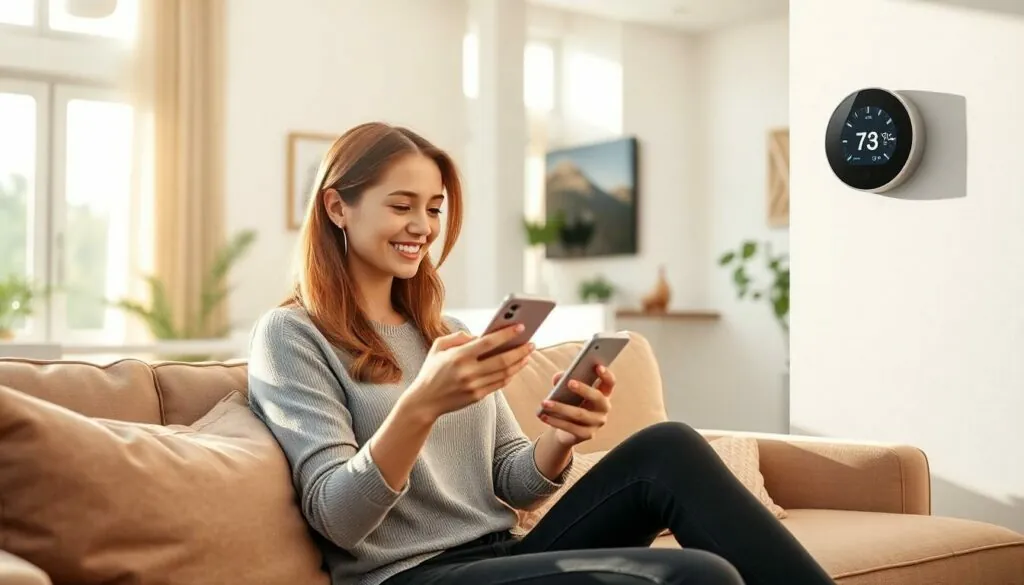Imagine walking into your home and feeling an instant wave of warmth, like a cozy hug from your favorite blanket. That’s the magic of smart home heating. Gone are the days of fiddling with thermostats or shivering in your own living room. With smart heating solutions, comfort meets convenience in a way that even your grandma would approve of.
These systems learn your habits, adjust temperatures automatically, and can even be controlled from your phone. They’re like having a personal butler who specializes in warmth—minus the bow tie and fancy accent. Not only do smart heating systems keep you toasty, but they also help save on energy bills, making your wallet feel as warm as your home. So, let’s dive into the world of smart home heating and discover how it can transform your living space into a sanctuary of comfort.
Table of Contents
ToggleOverview of Smart Home Heating
Smart home heating integrates advanced technology into home heating systems. These systems automatically learn user preferences and adjust accordingly. Users benefit from apps that provide remote access to their heating settings. Energy efficiency is a significant advantage, as smart thermostats optimize usage based on when occupants are home.
These devices often feature sensors that detect room occupancy or temperature. With such features, they promote consistent comfort throughout the living space. Many smart heating systems can also interact with other smart devices, creating a harmonious home environment. For instance, integration with smart lighting systems enhances energy management and ambient control.
Smart heating solutions display user-friendly interfaces, making operation intuitive. A variety of models are available, ranging from smart thermostats to complete home heating systems. Some systems can be programmed for specific times and settings, catering to the individual’s lifestyle needs.
Recent studies indicate that smart heating can reduce energy costs by up to 30%. High adaptability allows these heating solutions to accommodate changes in seasons and daily routines seamlessly. As technology advances, the potential for further integration with renewable energy sources increases, aligning with sustainable living practices.
Transitioning to smart home heating not only elevates comfort but also encourages responsible energy consumption. Homeowners increasingly seek modern solutions that provide convenience alongside savings. The flexibility of these systems supports diverse living situations, whether in urban apartments or spacious homes.
Benefits of Smart Home Heating

Smart home heating offers significant advantages, enhancing both comfort and efficiency. These benefits encompass energy efficiency, cost savings, and enhanced comfort.
Energy Efficiency
Smart heating systems excel in energy efficiency through advanced technology. They adjust to user habits, optimizing energy consumption based on real-time occupancy data. Systems can reduce heating output in unoccupied rooms, minimizing waste. Homeowners often experience a noticeable decrease in energy usage, contributing to a lower carbon footprint. Reports indicate that smart heating can improve efficiency by up to 30%, making a substantial impact on monthly energy bills.
Cost Savings
Cost savings become apparent with smart home heating as enhanced energy efficiency translates directly to lower utility bills. Systems equipped with algorithms analyze usage patterns, ensuring heating only occurs when necessary. Homeowners frequently save up to 30% on energy costs with these systems. Incentives and rebates for smart home installations may also provide additional financial relief. As a result, investing in smart heating often pays off within a few years, establishing a budget-friendly choice for homeowners.
Enhanced Comfort
Enhanced comfort arises from the ability of smart heating systems to learn user preferences. Automatic adjustments maintain optimal temperatures, creating a cozy environment throughout the home. Many models offer personalized settings for rooms, accommodating individual comfort levels. Remote access via smartphones allows users to adjust heating from anywhere, ensuring a warm welcome upon arrival. Overall, smart heating solutions guarantee a consistently comfortable atmosphere that adapts to changing lifestyles.
Popular Smart Home Heating Systems
Smart home heating systems offer a variety of solutions for optimizing comfort and energy efficiency. Below are two of the most popular types.
Smart Thermostats
Smart thermostats enhance home heating by learning user schedules and preferences. This technology adjusts temperatures automatically based on actual occupancy, ensuring efficient energy use. Many models allow remote access through smartphones, giving homeowners control even when away. Significant savings are possible, with studies indicating reductions in energy costs by up to 30%. Popular options include Nest, Ecobee, and Honeywell, each featuring unique functionalities tailored to fit different lifestyles. Homeowners benefit from intuitive interfaces that facilitate easy programming and monitoring of energy consumption.
Radiant Floor Heating
Radiant floor heating systems distribute warmth evenly across surfaces, providing consistent temperatures in various areas. As they can operate with lower temperature settings, these systems promote energy efficiency while maintaining comfort. Many installations utilize electric or hydronic systems, allowing flexibility in design. Installing radiant heating beneath floors can eliminate the need for traditional heaters, further optimizing space usage. Homeowners appreciate the feeling of warm floors, especially in colder seasons. Different materials, such as tiles and carpets, can effectively accommodate this type of heating. This system complements smart thermostats, optimizing control over indoor climates for enhanced energy management.
Installation and Setup
Smart home heating systems require proper installation and setup to function optimally. Homeowners can choose between DIY methods or hiring professionals for installation based on their comfort level and expertise.
DIY vs. Professional Installation
DIY installation offers cost-saving benefits, allowing homeowners to save on labor expenses. Many smart thermostats include user-friendly instructions and video tutorials to simplify the process. Those who possess basic electrical and home improvement skills can successfully install such devices. However, complex systems like radiant floor heating often require professional expertise due to intricate design and zoning. Engaging a professional ensures compliance with building codes and enhances system efficiency. Professionals also offer warranties, which can add peace of mind.
Compatibility with Existing Systems
Compatibility is crucial when integrating smart heating into a home. Many smart thermostats function with conventional HVAC systems, providing seamless upgrades. It’s important to check compatibility with existing setups to ensure proper functionality. Radiant floor heating, whether electric or hydronic, may also integrate with smart controls, optimizing performance. Homeowners find that researching models, reading reviews, and consulting with heating experts helps confirm suitability. Ultimately, ensuring compatibility leads to improved energy efficiency and enhanced user experience.
Future Trends in Smart Home Heating
Emerging technologies shape the future of smart home heating, enhancing user experience and energy efficiency. Increasing emphasis on integration across smart devices provides seamless interactions, enabling systems to coordinate for optimized energy management. Companies are designing more advanced algorithms that analyze data, anticipate user needs, and dynamically adjust heating settings.
User interfaces continue evolving, with voice activation becoming standard. Homeowners appreciate the convenience of controlling heating through simple voice commands, eliminating reliance on physical devices. Furthermore, machine learning capabilities enable systems to refine their performance, creating personalized heating schedules that adapt to lifestyle changes.
Internet of Things (IoT) connectivity becomes crucial as more devices connect to the network, maximizing efficiency. Systems can respond to external factors like weather forecasts, adjusting temperatures proactively. Enhanced features, including geofencing technology, allow devices to monitor user locations, ensuring energy-saving measures activate when the home is unoccupied.
Sustainability remains a priority, with manufacturers focusing on eco-friendly solutions. Innovations like solar-assisted heating are gaining traction, allowing homeowners to utilize renewable energy sources. Electric heat pumps are also rising in popularity, offering greater efficiency with lower carbon emissions compared to traditional systems.
In an era of smart home automation, integration with renewable energy sources signifies a transformative trend. Households can increasingly rely on smart heating systems to manage energy consumption efficiently while promoting eco-conscious living. As advancements continue, the integration of smart heating technologies aims to create not just warm homes but sustainable environments that benefit both users and the planet.
Smart home heating systems offer an innovative way to enhance comfort and efficiency in any living space. By leveraging advanced technology these systems not only adapt to user preferences but also optimize energy consumption. Homeowners can enjoy significant cost savings while contributing to a more sustainable environment.
As smart heating continues to evolve integrating with other smart devices it promises even greater energy management capabilities. With a variety of options available there’s a solution for every lifestyle. Embracing smart home heating isn’t just about comfort; it’s a step toward a more energy-efficient and eco-friendly future.






